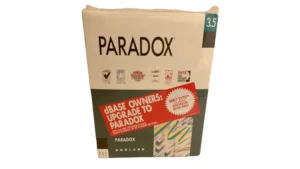In the evolving realm of computer networking and database management, some names stand the test of time and etch an indelible mark on history. One such name is Paradox, a marvel of the 1980s and 1990s, holding its ground as a leading database management system (DBMS). For computer science students eager to grasp the expansive lineage of DBMS technology, understanding Paradox is tantamount to understanding a vital piece of the tech world’s legacy.
But what led to its surge in popularity, and why is it imperative to be conversant with its details today? The tapestry of Paradox’s history offers insights into the evolution of database management and sets a foundational context for the progression of modern systems. In this exploration, we’ll immerse ourselves in the world of Paradox, rekindling the awe and reverence it once commanded.

What was Paradox Database?
Paradox began its journey in the early 1980s as a desktop database management system for the CP/M operating system. Developed by Ansa Software, its initial iteration was recognized for its unique query-by-example feature, which set it apart from its competitors. But the real surge in its popularity came when Borland, a titan in software development at the time, acquired Ansa Software. Under Borland’s umbrella, Paradox was transitioned to function on DOS, which was burgeoning as the primary OS for personal computers.
While Paradox’s interface was characterized as user-friendly, its true strength was its powerful querying capabilities and the unique approach of a “visual” query system. As time progressed and technology advanced, Paradox evolved to include features for Windows and became more integrated, allowing for better compatibility with other software tools. This adaptive nature, coupled with its powerful performance, solidified its reputation as a formidable DBMS during its peak years.
Paradox for Windows
Paradox for Windows is a significantly different product than its DOS counterpart, developed by a separate programming team. Its applications use ObjectPAL, a programming language distinct from the DOS version’s PAL. This shift was necessary since PAL was keystroke-based and unsuitable for Windows. Instead, ObjectPAL, inspired by Hypercard, was integrated with visual elements and utilized a user-friendly right-click interface.
This interface, influenced by Xerox Alto and Smalltalk, is now a standard in many Windows applications. Development of this version initially used C programming, transitioning to C++ once Turbo C++ became available. Joe Duncan managed the project until its 1.0 version, with a team of around 30 for development and quality assurance. Although Paradox for Windows began development in early 1990, it faced a year’s delay, launching in 1993 due to challenges arising from the complete overhaul in an object-oriented language and a new GUI paradigm. This delay allowed Microsoft to release Access ahead of Paradox, giving Microsoft a marketing advantage.
Borland Acquire Ashton-Tate
In 1990, Borland began developing a dBASE clone for both DOS and Windows. By 1992, seeing Ashton-Tate struggle with Windows product development, Borland acquired the company, designating their in-house project as the successor. This acquisition included the InterBase rdbms, prompting Borland to make Paradox/W compatible with both InterBase and the Paradox engine, resulting in an IDAPI engine centered on InterBase.
This acquisition altered Borland’s direction. Initially, Paradox competed with dBASE and aimed at strengthening its position in the developer market. Post-acquisition, the focus pivoted to user-friendliness. However, adjusting the product to this new aim was challenging, rendering it somewhat intricate for new users.
Microsoft released Access
Meanwhile, Microsoft released Access in November 1992, targeting the same user-friendly market and beating Borland. Microsoft then bought FoxPro to enhance Access’s performance, making it more intuitive and efficient than Paradox. Notably, Access displayed query results more efficiently than Paradox, especially for extensive datasets.
In a competitive move, Microsoft priced Access at $99, dramatically undercutting the typical $799 DBMS prices of products like Paradox, which severely affected Borland’s market position.
Borland, despite commanding 85% of the desktop database market, underestimated Microsoft Access’s looming influence. While Paradox/W initially sold well, Borland faced challenges stemming from its Ashton-Tate acquisition, leading to product discontinuations, restructuring, and a decline in revenues. The key motive for the acquisition, the internal dBASE project, was scrapped for technical reasons, putting pressure on Borland to quickly produce dBASE for Windows.
However, the Windows iteration deviated from dBASE for DOS, losing its crucial multi-vendor support, which fragmented the market. Neither Borland’s Visual dBASE for Windows nor Microsoft’s Foxbase for Windows supported programs from the other, leading to diminished brand loyalty.
Access included in Microsoft Office Professional Suite: A Killer move
Microsoft’s strategic move in 1995 to include Access in the Microsoft Office Professional Suite severely hurt standalone desktop database products. Paradox lost its market prominence and changed hands multiple times, eventually becoming part of Corel’s product suite. Borland’s late release of dBASE for Windows saw minimal adoption as most developers had shifted to Microsoft FoxBASE. Borland chose to concentrate on its Delphi tools, ensuring a niche but influential position in the developer market.
Corel Paradox
In the mid-1990s, Corel acquired rights to Paradox, releasing Corel Paradox 8 in 1997. It was also bundled with the professional version of Corel’s WordPerfect Office suite, spanning multiple releases up to 2020. However, the last update was in 2009 with the Paradox Hot Fix 1 for X4, and all subsequent releases maintained the version 11.0.0.676.